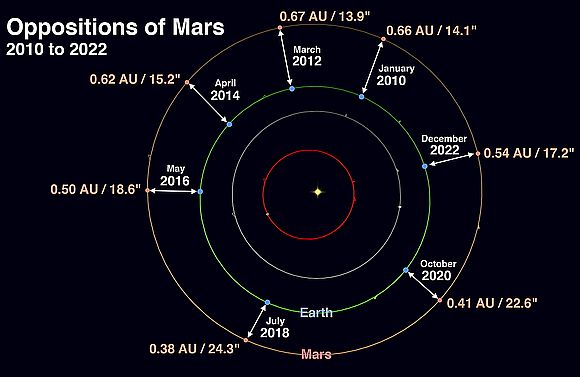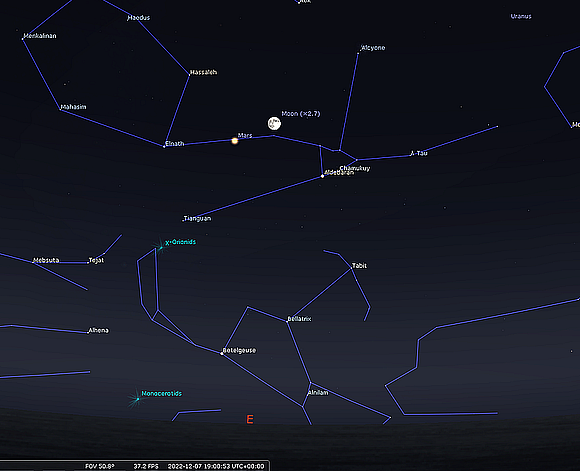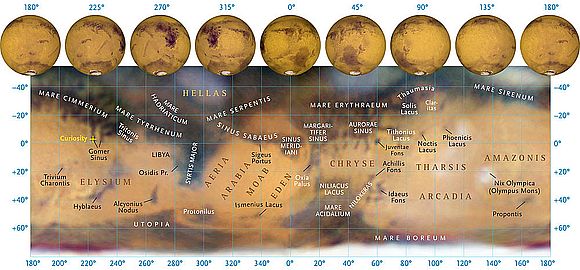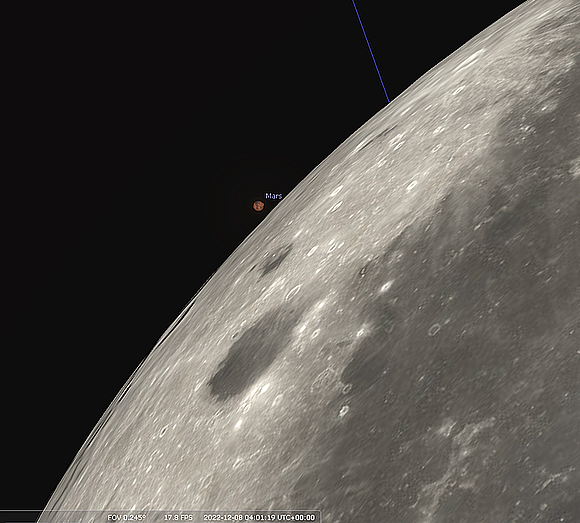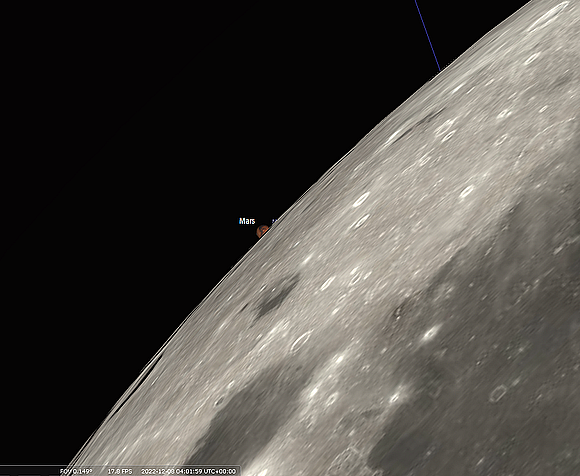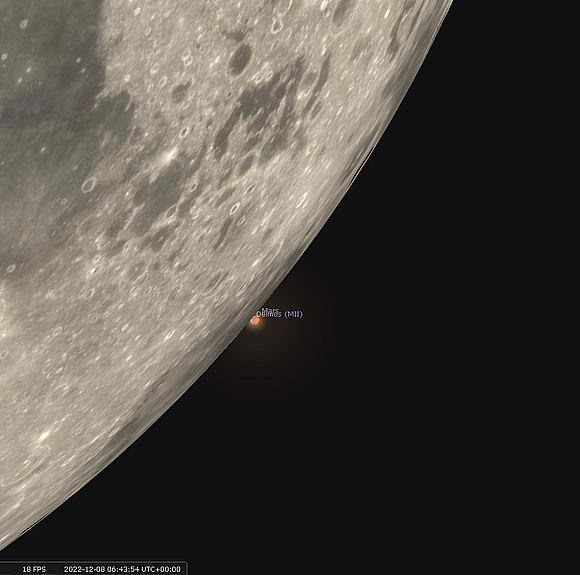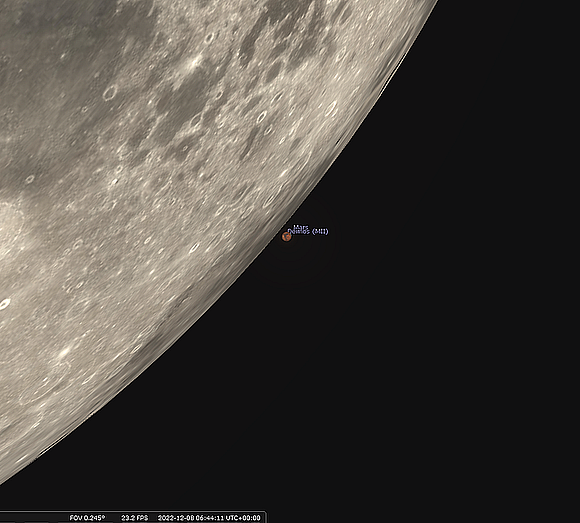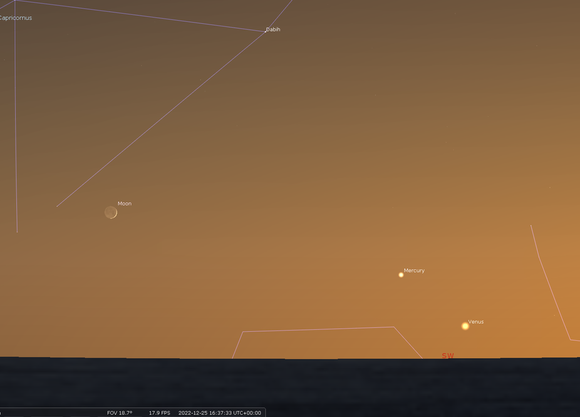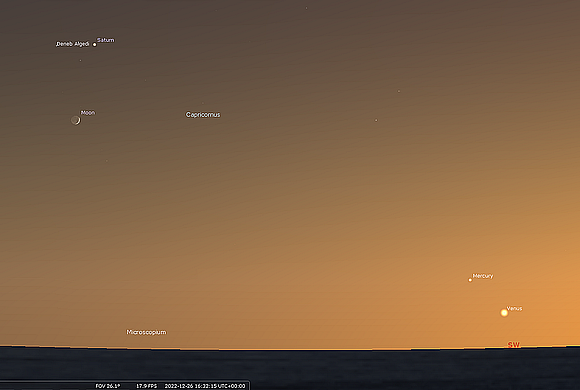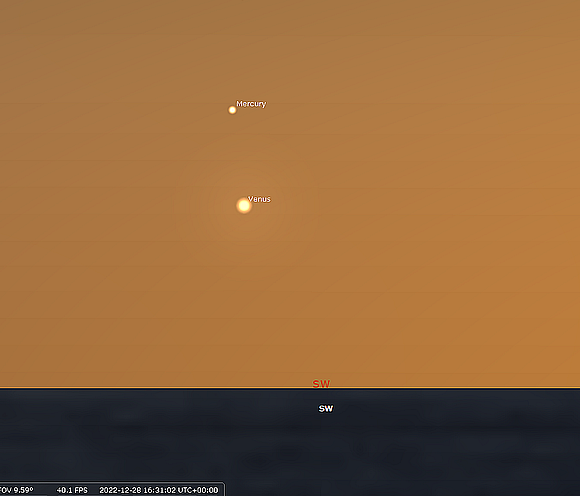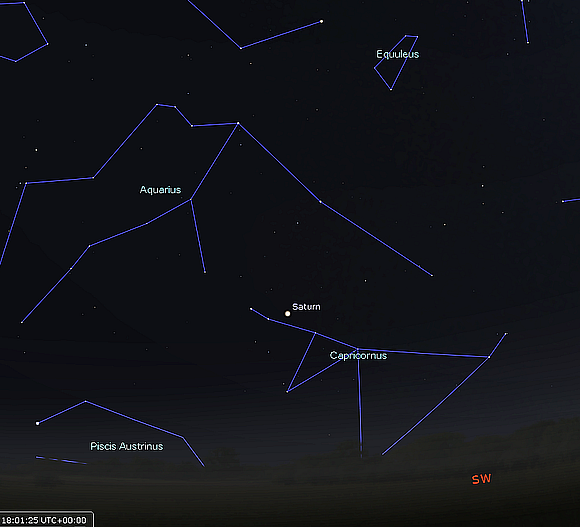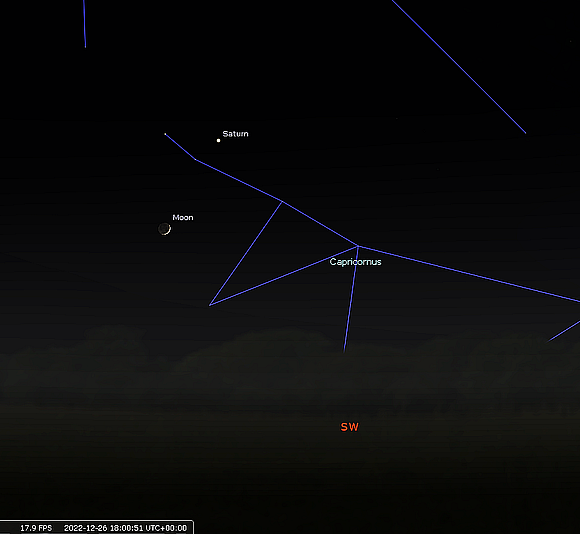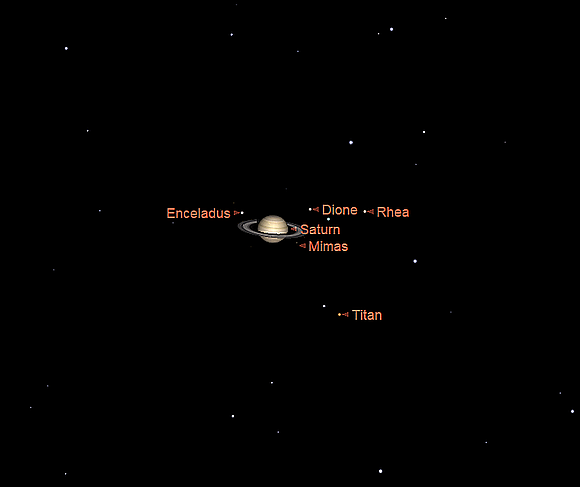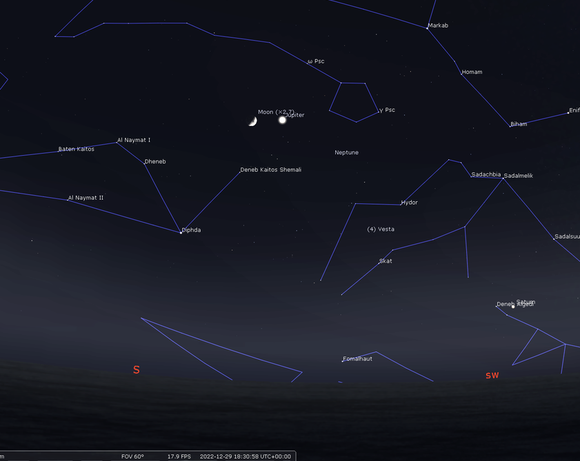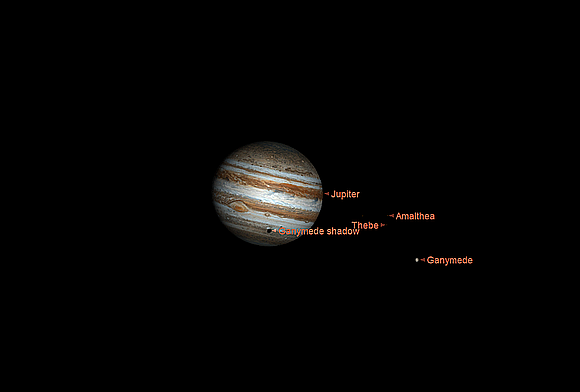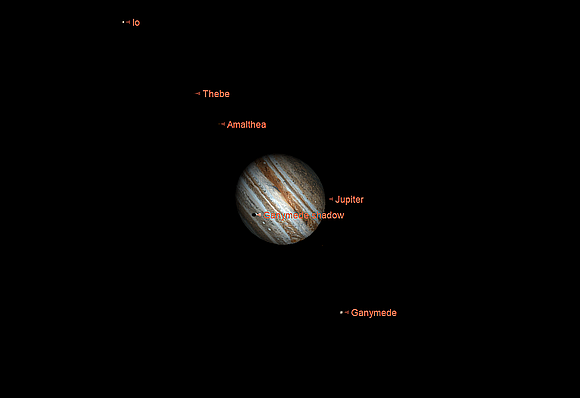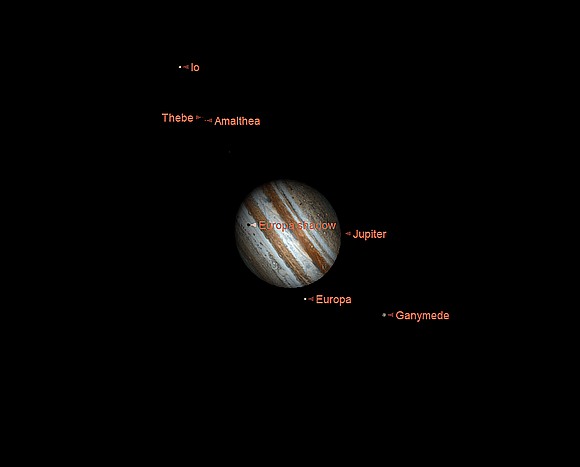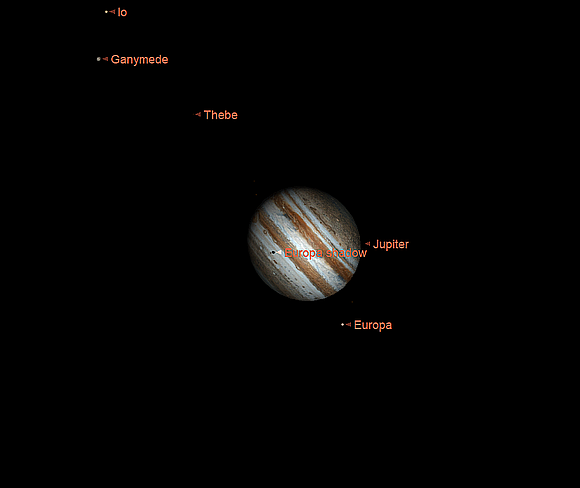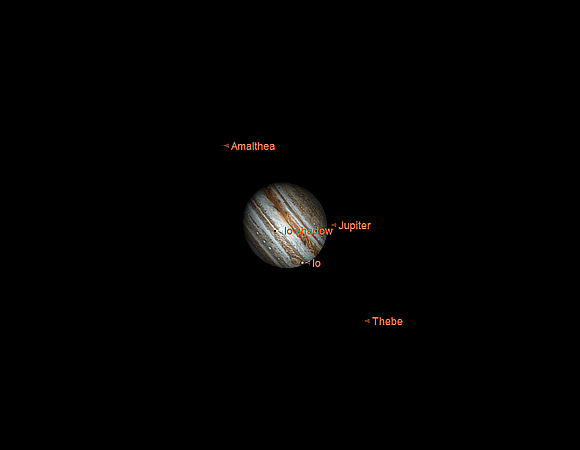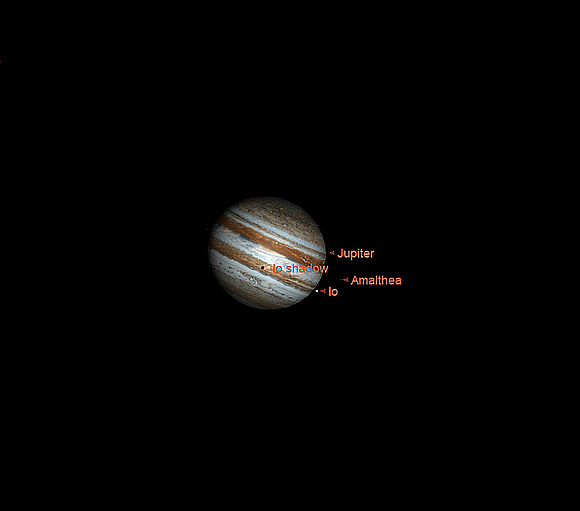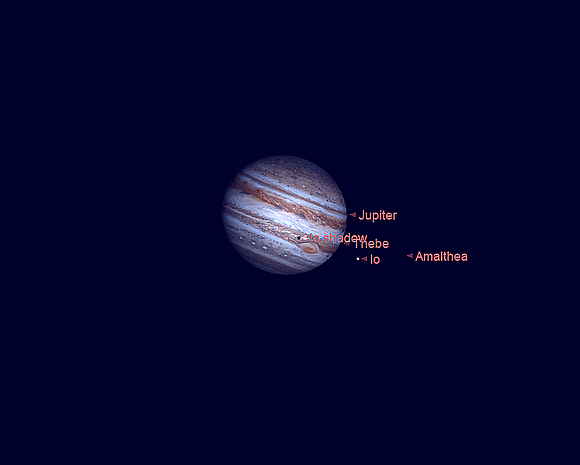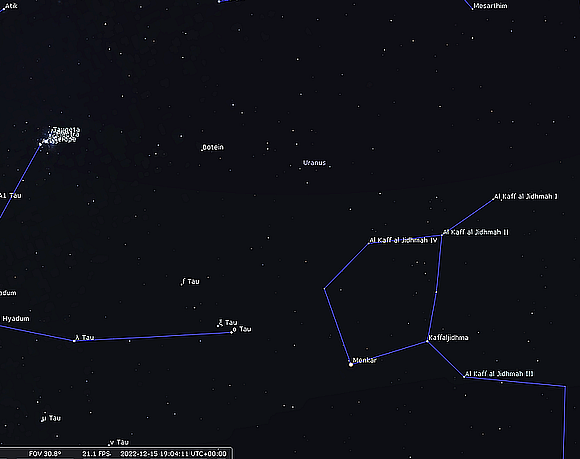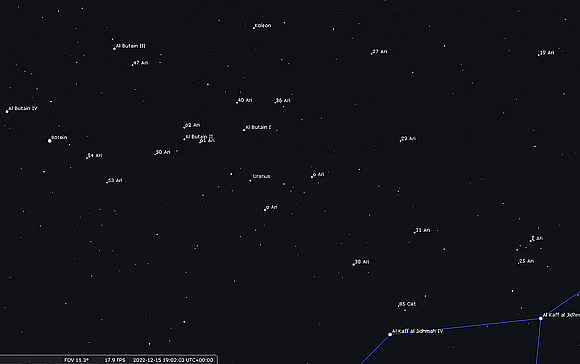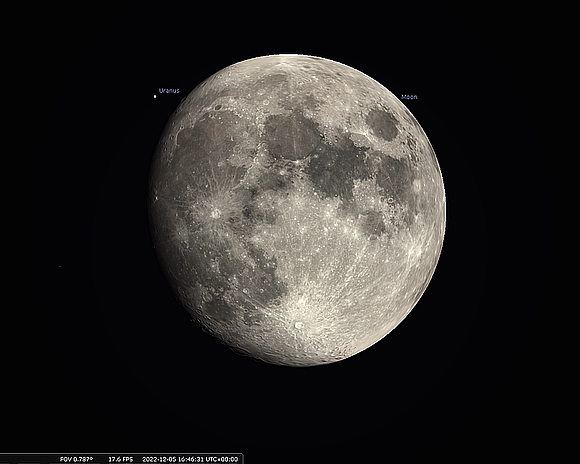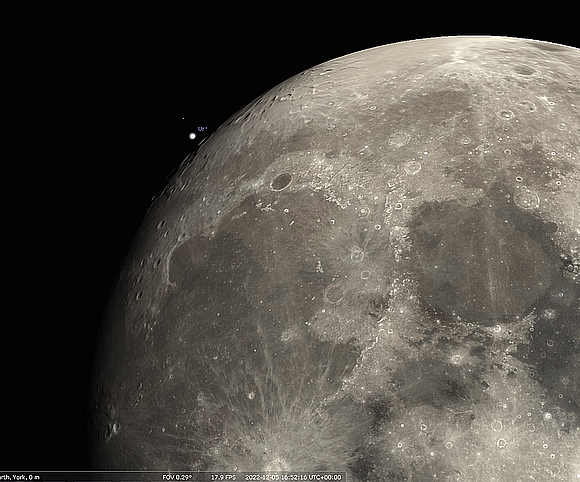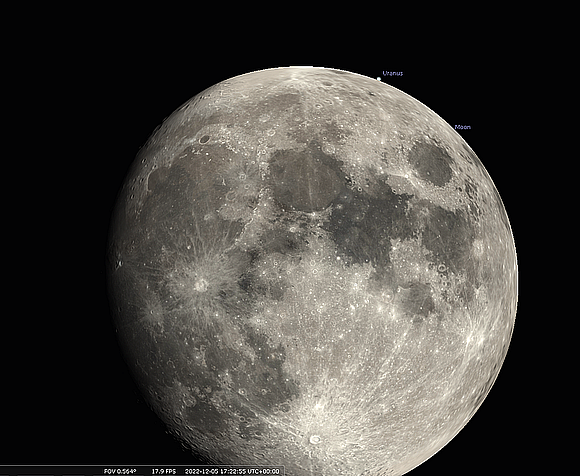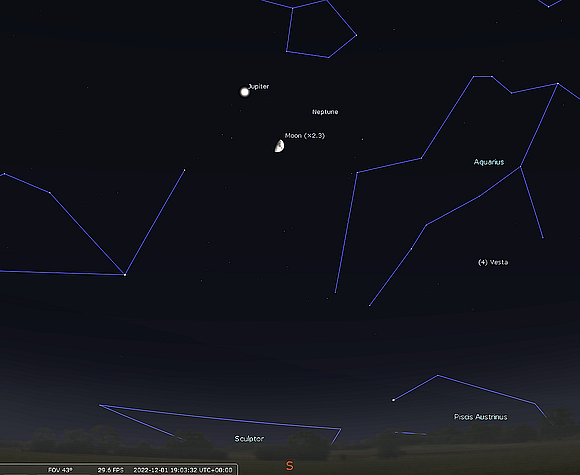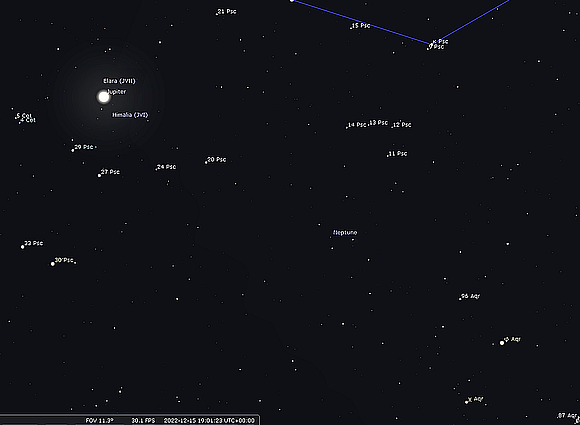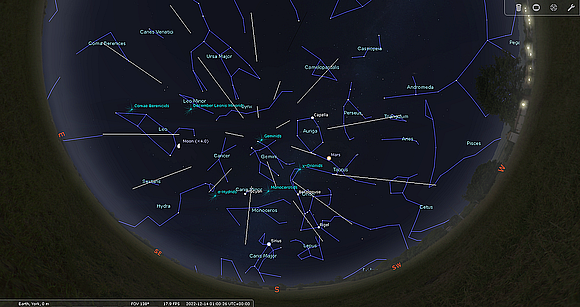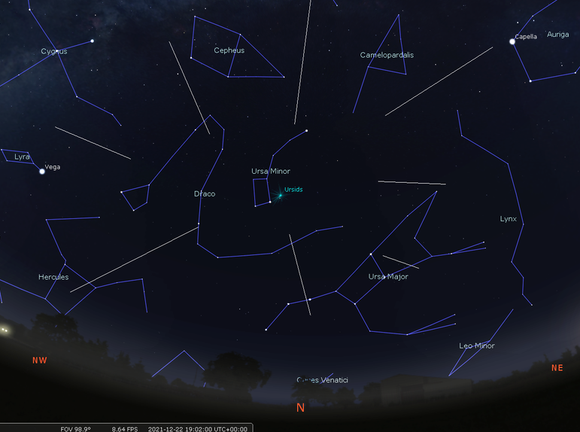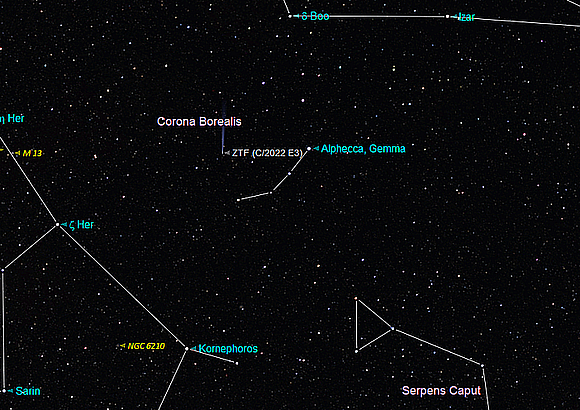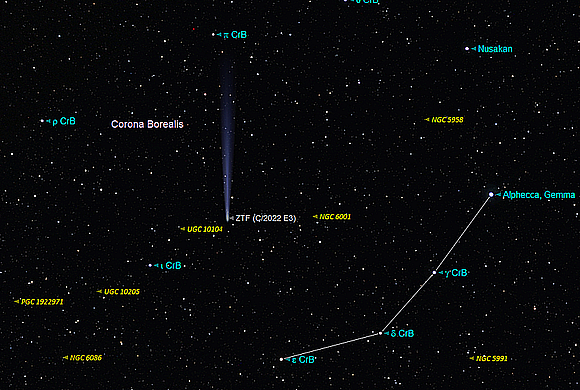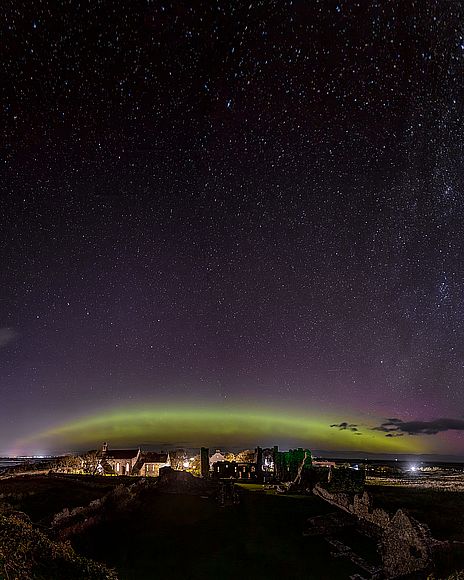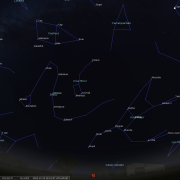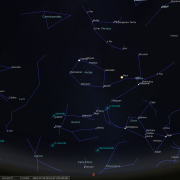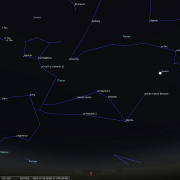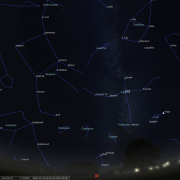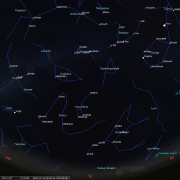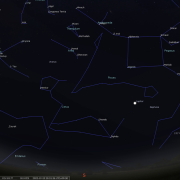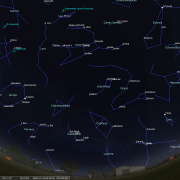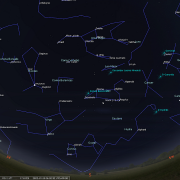In this month's Sky Notes:
- Planetary Skylights.
- December Meteors and Comets.
- December Night Sky.
- Winter Solstice.
- December 2022 Sky Charts.
Planetary Skylights - Brief
December is a busy month: Mars comes to opposition and is occulted by the Moon, as is distant Uranus. Jupiter is a treat to observe, Saturn sinks into SW, Venus and Mercury may be glimpsed at the end of the month.
 Mars - the Red Planet comes to opposition on December 8th, over two years since it last did so. Of all the planets that come to opposition Mars is the one to spark interest for amateur astronomers and to some extent the general public. People are more aware of the growth in brightness of Mars as it approaches opposition, a highly conspicuous ochre presence to the naked eye, which carries a mystique other planets do not conjure up. People are, and have been fascinated with the Martian world for well over a century, in science fiction works, films and scientifically. It is the only other planet that we can directly view the surface in relatively close order, at times a surface which is less than 34 million miles (52 million km) distant. Mars is the next planet out from Earth which accounts for its 780 day interval between oppositions. Due to the eccentricity of Mars's orbit (6 times more oval shaped than Earth's) its separation from Earth varies considerably at oppositions, from 54 million km (34 million miles) to 101 million km (63 million miles). Indeed of all the planets, Mars shows the greatest variation in its apparent size and brightness. Its angular size varies by a factor of more than seven, between 25.69" and 3.49" For the 2022 opposition Mars is actually closest to Earth on December 1st some 81 million km (52 million miles) but does not reach opposition (when opposite the Sun in the sky) until December 8th at 05:35hrsUT - when bizarrely it won't be visible from the UK at all!, but more on that shortly.
Mars - the Red Planet comes to opposition on December 8th, over two years since it last did so. Of all the planets that come to opposition Mars is the one to spark interest for amateur astronomers and to some extent the general public. People are more aware of the growth in brightness of Mars as it approaches opposition, a highly conspicuous ochre presence to the naked eye, which carries a mystique other planets do not conjure up. People are, and have been fascinated with the Martian world for well over a century, in science fiction works, films and scientifically. It is the only other planet that we can directly view the surface in relatively close order, at times a surface which is less than 34 million miles (52 million km) distant. Mars is the next planet out from Earth which accounts for its 780 day interval between oppositions. Due to the eccentricity of Mars's orbit (6 times more oval shaped than Earth's) its separation from Earth varies considerably at oppositions, from 54 million km (34 million miles) to 101 million km (63 million miles). Indeed of all the planets, Mars shows the greatest variation in its apparent size and brightness. Its angular size varies by a factor of more than seven, between 25.69" and 3.49" For the 2022 opposition Mars is actually closest to Earth on December 1st some 81 million km (52 million miles) but does not reach opposition (when opposite the Sun in the sky) until December 8th at 05:35hrsUT - when bizarrely it won't be visible from the UK at all!, but more on that shortly.
In the sky Mars is noticeable as soon as dusk falls when it lies in the east. By midnight Mars will be located high to the south, setting in the west as dawn breaks. At magnitude - 1.72 around opposition date, Mars dominates Taurus, the constellation it currently resides in, making Aldebaran (chief star in the Bull and also of orange hue) seem pale in comparison. The Red Planet reaches a maximum declination on Dec 6th, 60 degrees or so above the South horizon. With a disk diameter of over 17 arc seconds at opposition, Mars will be a viable observing target all night and at that altitude the image through the eyepiece for UK observers should be superior to anytime over the last few decades with surface detail glimpsed in even modest aperture scopes. Mars will be in retrograde motion (east to west), gathering momentum as the month wears on and drifting toward and above Aldebaran. This direction of travel will come to a halt by mid January, resuming a prograde motion back toward the horn stars of Taurus thereafter.
Although higher in the sky, Mars will still be quite challenging to observe being only around 75% the size it appeared in 2020. Patience at the eyepiece will be required as seeing on clear nights will vary. As a rough guide, clear skies with twinkling stars usually equates to unsteady seeing. Those nights with perhaps a little haze, but with steady stars will yield better views. Magnifications of around 100x will yield an image of Mars similar to how the naked eye perceives a Full Moon. If you roughly use 40X per 25mm of aperture, but don’t exceed 130x magnification whatever the scope employed, images will be reasonably bright and detail sharp or at least visible. One factor out of our hands entirely will be the conditions on Mars itself, sometimes dust storms blow up, as was the case in 1971, 2001 and 2018, blotting out surface detail for days or weeks, as in 1971 when Mars appeared a featureless orange ball for several weeks.
The most obvious surface feature when apparent on Mars is Syrtis Major - a dark fin shape. Below (or above dependent on optical orientation) Syrtis Major sits the huge Hellas depression. Other features to look for are Mare Erythraeum, Sinus Sabaeus, which adjoins Mare Serpentis, Mare Acidalium and Utopia and the lighter 'desert' areas of Elysium, Tharsis and Amazonis on which Olympus Mons towers, the largest volcano in the solar system. Around Opposition date the paler regions of Tharsis and Amozonis will be visible. Syrtis Major is apparent over the Christmas period from Dec 23rd onwards.
As briefly hinted at earlier, opposition day for Mars is particularly eventful, with the Full Moon occulting Mars during the early morning hours of Dec 8th. If you want to view this for yourself, set the alarm clock as you’ll need to be ready for 04:00hrs UT as shortly after Mars will be disappear behind the bright lunar limb. Egress will occur around 06:40hrs UT - an alarm call for 06:15hrs perhaps? These times are for Whitby and will vary slightly from UK locations and Western Europe. If conditions allow, and you don't mind an early start, the 2022 opposition of Mars will be one to remember for a number of reasons.
The Full Moon is 'near' Mars overnight of Dec 7th/8th.

 Mercury and Venus are visible (just) in the evening twilight sky later in December. Start to look for them from December 19th onwards just above the SW horizon around 16:15hrs. You will require a clear, flat horizon; any trees, houses, hills and the like will in all probability hide them. Lighting levels at that time will be quite bright still and you won't have much time before the planets set, so perhaps use binoculars. At magnitude -3.8 Venus will be far the brighter of the two and should be apparent to the naked eye. Mercury will also be at its brightest early in the apparition, though at mag - 0.55 will be more difficult pick out of the light skies in that direction. A crescent Moon will lie off to the left of Mercury and Venus on Christmas Day and below Saturn a day later, making for a fine planetary vista. By December 28th Mercury resides directly above Venus at 16:30hrs, but will be less bright than earlier in its apparition. Both planets will lie just a few degrees above the horizon, the observing 'window' will therefore be critical, barely 25 minutes before setting, a Christmas observing challenge!
Mercury and Venus are visible (just) in the evening twilight sky later in December. Start to look for them from December 19th onwards just above the SW horizon around 16:15hrs. You will require a clear, flat horizon; any trees, houses, hills and the like will in all probability hide them. Lighting levels at that time will be quite bright still and you won't have much time before the planets set, so perhaps use binoculars. At magnitude -3.8 Venus will be far the brighter of the two and should be apparent to the naked eye. Mercury will also be at its brightest early in the apparition, though at mag - 0.55 will be more difficult pick out of the light skies in that direction. A crescent Moon will lie off to the left of Mercury and Venus on Christmas Day and below Saturn a day later, making for a fine planetary vista. By December 28th Mercury resides directly above Venus at 16:30hrs, but will be less bright than earlier in its apparition. Both planets will lie just a few degrees above the horizon, the observing 'window' will therefore be critical, barely 25 minutes before setting, a Christmas observing challenge!
 Saturn is now dropping down into the murk above the SW horizon by mid evening, so view early on in December as soon as skies grow dark for reasonable observations in the eyepiece. By the end of the month Saturn is setting shortly after 19:00hrs. The planet sits amongst the stars of west Capricornus and is still the brightest object in that aspect of the sky with an apparent magnitude of +0.5, reasonably conspicuous to the naked eye. Through the eyepiece Saturn appears almost 19 arc seconds in diameter with the rings spanning 42 arc seconds. The rings are a magical sight and remain favourably orientated with respect to Earth; the North Pole tilted over 12 degrees toward us, taking another 4 years before we arrive at the next ring plane crossing event.
Saturn is now dropping down into the murk above the SW horizon by mid evening, so view early on in December as soon as skies grow dark for reasonable observations in the eyepiece. By the end of the month Saturn is setting shortly after 19:00hrs. The planet sits amongst the stars of west Capricornus and is still the brightest object in that aspect of the sky with an apparent magnitude of +0.5, reasonably conspicuous to the naked eye. Through the eyepiece Saturn appears almost 19 arc seconds in diameter with the rings spanning 42 arc seconds. The rings are a magical sight and remain favourably orientated with respect to Earth; the North Pole tilted over 12 degrees toward us, taking another 4 years before we arrive at the next ring plane crossing event.
A telescope with an aperture of 80-100mm (3.5 - 4") will reveal the brightest rings (A & B) separated by the Cassini Division. Saturn's largest moon, Titan, is noticeable as a speck of light nearby and at mag +8.4 may be spied in small scopes. Titan takes just under 16 days to orbit around Saturn. A slim crescent Moon sits below left of Saturn on Dec 26th at 18:00hrs.
 At magnitude -2.5 Jupiter remains the most dominant planetary object in the night sky, even though Mars will steal the show as it reaches opposition. Jupiter will still be well placed for UK observers, located quite high to the South as dusk gathers. Residing below the faint ‘loop’ stars of Pisces and culminating a respectable 35 degrees above the horizon, planetary observers still have plenty of opportunity to scrutinise Jupiter over the course of December, although by the end of the month it is setting by 23:00hrs. A quarter phase Moon lies left of Jupiter overnight of Dec 28/29th.
At magnitude -2.5 Jupiter remains the most dominant planetary object in the night sky, even though Mars will steal the show as it reaches opposition. Jupiter will still be well placed for UK observers, located quite high to the South as dusk gathers. Residing below the faint ‘loop’ stars of Pisces and culminating a respectable 35 degrees above the horizon, planetary observers still have plenty of opportunity to scrutinise Jupiter over the course of December, although by the end of the month it is setting by 23:00hrs. A quarter phase Moon lies left of Jupiter overnight of Dec 28/29th.
Through the eyepiece Jupiter is a fine sight, the oblate disk appearing an impressive 46 arc seconds in diameter and fascinating to study. Observers should note changes to disk features, including the banding and GRS (Great Red Spot). The Great Red Spot (GRS) is a colossal storm system, which over the last few decades appears to have diminished in size and hue intensity and is now carefully monitored by astronomers. It is visible in apertures of 100mm (4") and above.
Jupiter is flanked by the Galilean moons' seen as specks of light close by, but planetary sized worlds in their own right. Regular observers of the Jovian system will note the 'dance' of Io, Europa, Ganymede and Callisto around Jupiter, throwing up a different configuration each night, with shadow transits particularly fascinating to follow. If you have a 4" (100mm) aperture scope' and above, shadow transits of moons passing on the near side of Jupiter will be visible, jet black dots of varying size dependant on which moon is involved.
The actual moons themselves are more difficult to spot as they pass in front of Jupiter, requiring much larger apertures. The most favourable evening shadow transits this month are Ganymede; Dec 1st @ 18:00hrs & Dec 8th @ 21:30hrs. Europa Dec 4th @ 22:30hrs & Dec 29th @ 20:00hrs. Io - Dec 3rd @ 22:00hrs; Dec 12th @ 18:30hrs and Dec 28th @ 17:15hrs.
 Uranus remains well placed for observation having reached opposition last month. Located in the lower reaches of Aries, Uranus is well clear of horizon murk culminating around 50 degrees above the south horizon by 22:00hrs. At magnitude +5.7, Uranus is just about visible to the naked eye, but dark, transparent, skies are required to achieve this. Uranus can be spotted as a star-like object through binoculars, but the miniscule disk; ghoulish grey/green in hue and just 4 arc seconds in diameter, is revealed only in telescopes of apertures 75mm (3") and greater at medium magnification.
Uranus remains well placed for observation having reached opposition last month. Located in the lower reaches of Aries, Uranus is well clear of horizon murk culminating around 50 degrees above the south horizon by 22:00hrs. At magnitude +5.7, Uranus is just about visible to the naked eye, but dark, transparent, skies are required to achieve this. Uranus can be spotted as a star-like object through binoculars, but the miniscule disk; ghoulish grey/green in hue and just 4 arc seconds in diameter, is revealed only in telescopes of apertures 75mm (3") and greater at medium magnification.
Perhaps the most difficult aspect of locating Uranus is indentifying the general area of sky it currently resides, a 'no man's land' devoid of apparent naked eye stars below Aries, west of Taurus and to the east of Cetus and Pisces. The nearest 'bright' apparent naked eye star is sigma Ari at magnitude +4.35, which sits 1.5 degrees upper left of Uranus. Over the course of a month you will notice the movement of Uranus in comparison to background stars. On Dec 5th Uranus is occulted by the gibbous Moon. Unlike the occultation of Mars few days later, the ingress of Uranus is fortunately at a more reasonable hour - 16:50hrs or thereabouts with egress occurring around 17:22hrs, quite a short occultation period. Should be a good time to track down the distant 2.8 billion km world!
 Remote Neptune is well placed for observation in the evening sky residing amongst the stars of northern Aquarius, some 6 degrees lower right of Jupiter. At a distance of 4.32 billion Km, Neptune appears a feeble magnitude +7.8 object, visible in binoculars as a speck only, a telescope with an aperture of at least 100mm (4") + is required to reveal its tiny blue/grey disk barely 2.5 arc seconds in diameter. Although Neptune resides just within the borders of Aquarius, the closest visible star is the mag +5.5 star 20 Piscium (HIP 117375) with 96 Aqr almost the same distance to the SW of Neptune. By the month’s end Neptune is setting by 21:30hrs.
Remote Neptune is well placed for observation in the evening sky residing amongst the stars of northern Aquarius, some 6 degrees lower right of Jupiter. At a distance of 4.32 billion Km, Neptune appears a feeble magnitude +7.8 object, visible in binoculars as a speck only, a telescope with an aperture of at least 100mm (4") + is required to reveal its tiny blue/grey disk barely 2.5 arc seconds in diameter. Although Neptune resides just within the borders of Aquarius, the closest visible star is the mag +5.5 star 20 Piscium (HIP 117375) with 96 Aqr almost the same distance to the SW of Neptune. By the month’s end Neptune is setting by 21:30hrs.
December Meteor and Comet Activity
Meteor activity reaches a peak at this time of year with two major meteor showers occurring within the space of 20 days. The chance of spotting a shooting star or two is therefore pretty high - weather permitting! First up are the Geminids, considered to be the most prolific annual meteor shower. The Geminids are active from December 7-16, reaching a peak this year in the early morning hours of December 14th. Geminid debris stems from a small asteroid called Phaethon which may even be the nucleus of a ‘dead’ comet. Phaethon passes within ten million miles of the Sun causing the object to deposit material over great swathes of the inner solar system. It is only within the second half of the 20th century that Geminid activity has increased to the levels now recorded, a result of Earth passing through a much denser debris strand, a situation that will continue only for another hundred years or so. The shower radiant lies close to Castor, in Gemini, visible in the east by 18:00hrs. Under ideal conditions the Zenith Hourly Rate (ZHR) exceeds 120; however observed rates are always lower. A typical Geminid meteoroid is about the size of a large coffee granule, brighter Geminids regularly produce long luminous trails, sometimes green or orange in hue. Like so many major meteor showers in 2022, moonlight will interfere, a waning gibbous moon hampering observations and restricting numbers. The evening of the 13th will fare better, but the radiant will be low down then and by the early morning hours of the 14th when Geminids reach a peak, the Moon, although waning will lie close to the radiant. Expect to witness 20-40 per hour at best.
Conditions for the less prolific Ursid meteor shower are much more favourable. The shower is active from Dec 17-25th, peaking on Dec 22/23rd, Hourly rates of around 10 are the norm, but occasionally and erratically, Ursids can produce strong outbursts, so it may be worth keeping an eye open that night. The radiant lies close to Kockab in Ursa Minor.
As we head into the New Year look out for the Quadrantid meteor shower, yet another prolific shooting star ‘fest’ with peak rates exceeding 100 in the early morning hours of the 4th. Therein lies the problem with this particular shower, the peak is almost always in the early morning hours and is short lived, usually a couple of hours. More on this shower next month.
Comet Activity - There are a number of comets visible, not unfortunately to the naked eye, but within reach of binoculars, small scopes and imaging devices. The most promising of these visitors from the depths of the solar system is comet 2022 E3 (ZTF) discovered in March by the Zwicky Transient Facility. This comet may very well become a naked eye comet in late January/early February 2023 as it's predicted to reach mag +4.5 and is already slightly brighter than estimates. In early December it lies in serpents Caput visible from 02:45hrs. At +7 it will require a pair of binoculars to spot it shortly before dawn - around 06:30hrs. By the end of the month comet E3 has moved up into Corona Borealis and will be over 50 degrees up in elevation by night’s end and perhaps a magnitude brighter. Images already show the comet sporting a small dust tail, so it's one to watch.
General location of Comet 2022 E3 (ZTF) late December 06:00hrs in Corona Borealis
(click for larger image)
Detailed location chart for Comet E3 (ZTF) late December 06:00hrs in Corona
(click for larger image)
And finally here is another fine image from Richard Randle from his Holy Island trip. This one is a panorama of 5 shots stitched together, with aurora and a myriad of stars, you can even see kemble's cascade if you zoom in!
The Winter Solstice

The Winter Solstice falls on December 21st this year marking the date when the Sun reaches its lowest position in the sky as seen from the Northern Hemisphere. From the latitude of Whitby the Sun will appear just over 12 degrees above S horizon at local noon. The Sun lies before the stars of Capricorn. The tilt of the northern hemisphere away from the Sun has now reached its maximum and useful daylight is at a minimum (barely 7 ½ hrs from Whitby) the shortest day. Latest sunrise and earliest sunset however do not occur on this date. The Sun rises latest around Dec 28th, but sets earliest mid-month. Astronomical winter commences for the Northern Hemisphere, but conversely days will slowly start to lengthen again. Cause for a celebration - surely, what shall we call it?!
December Night Sky
Having not long completed our tour of seasonal autumnal constellations, celestial winter is about to take centre stage, however before our undivided attention is focused towards this aspect, let us take a look at the big celestial picture, starting in the North, where most of the circumpolar groups – those that do not set from our latitude, are to be found. Included amongst these are the two bears; Ursa Major and Minor. The Plough, the familiar ‘saucepan’ asterism, which is part of Ursa Major, prowls above N horizon. Directly above the Plough sits Ursa Minor in which the Pole star, Polaris resides (use the pointer stars in the bowl of the Plough -Dubhe and Merak to locate it). The Celestial dragon – Draco winds its way between the bears towards the NNW where the head of the beast is marked by an irregular quadrilateral of stars. A little further west of this asterism and at the same altitude, sparkling steely blue Vega, the most conspicuous of the summer triangle stars, catches the eye in Lyra, whilst the stars of Cygnus, hang in crucifix form below its chief star Deneb above the WNW horizon. Just above the west horizon before 21:00hrs you may catch sight of Altair in the constellation of Aquila the Eagle, the only member of the summer triangle to depart our skies. Throughout the early part of the evening the zenith, the location directly overhead is occupied in turn by the distinctive ‘W’ pattern of Queen Cassiopeia, then by Perseus, the outline of which resemble a distorted figure Pi symbol and much later in the evening the stars of Auriga the charioteer, highlighted by brilliant Capella.
Initially in December the southern aspect is occupied in the South by the great square of Pegasus below which reside the less conspicuous constellations of Pisces and Aquarius. Cetus the whale churns along the South horizon below Pisces; use the front two stars in the square to locate the 'Krakens' brightest star Diphda. The most famed object in Cetus is the variable star omicron ceti - otherwise known as Mira the wonderful, an extraordinary pulsating red super giant up to 300 million miles in diameter. Capricornus occupies the SSW horizon, departing early evening skies by mid month. Try to spot conspicuous Fomalhaut in Pisces Austrinus, visible just above the SW horizon during early/mid evening until around 20:00hrs. It is the most southerly of first magnitude stars to rise over UK mainland shores. Scheat and Markab in the square of Pegasus point down to it during the first week in December.
By mid December it is the southern half of the night sky which rightly gains the plaudits, one of nature’s finest free vistas. In this direction an observer is treated to an array of brilliant stars and imposing constellations, rich in mythology and observational interest, whether using binoculars, a telescope or just the naked eye. Located at the heart of this glittering tableau stands the mighty hunter, Orion, The main outline is quite distinct, three stars in a sloping line set in the midst of a larger rectangle bounded by 4 others. Two of these stars, in opposing corners are real super luminaries’. Searing blue/white Rigel illuminates the bottom right of the rectangle, a star of spectral class B7 that is perhaps 60 – 75,000 times more luminous than our Sun, whilst the top left corner is occupied by Betelgeuse, a red super-giant star of deep orange hue, a clear indication of its age and cooler temperature. Rigel is massive enough to end its days as a supernova, tens of millions years in the future, short enough by stellar standards, however of all the naked eye stars visible in the night sky, Betelgeuse is probably the strongest candidate to go supernova first, perhaps in less than 10-20 thousand years. Betelgeuse has already ballooned to gargantuan proportions, over 400 million miles in diameter. Put another way, if Betelgeuse were at the heart of our solar system it would extend out beyond the orbit of Mars.
Situated beneath the three stars marking Orion’s belt is one of the heavens great show piece objects. Seen clearly as a misty smudge through binoculars, the Orion nebula is the nearest region of stellar birth around 1250 light years distant. The Nebula consists of a huge cloud of gas and dust in which new stars are “born”. Telescopically the nebula is quite breathtaking, a swirl of nebulous cloud at the heart of which reside the Trapezium stars, the four “bully boys” of this stellar crèche, little more than 10 million years old. Bearing down on Orion's right shoulder is Taurus the Bull (part of which adjoins Auriga above). Taurus is home to the open star clusters, the Pleiades and the Hyades. Prominent ruddy Aldebaran - “the eye of the bull’ is the most conspicuous presence in the Hyades, a ‘V’ or arrowhead arrangement of stars, though it is not a genuine member, lying at half the distance of true members. Brilliant Mars currently resides in Taurus to the left of Aldebaran and is of a similar hue. A little further west, upper right of the Hyades, the Pleiades star cluster (Seven Sisters) is truly a beautiful sight in binoculars or low power eyepiece, and one of the most youthful clusters by stellar standards. Keen sighted observers can make out more than seven stars with the naked eye, although most people see five or six. Binoculars, or very low telescopic magnifications reveal dozens of stars and the entire cluster contains over 300 members approximately 400 light years away. Upper left of Orion stand the Twins of Gemini, marked by the two conspicuous stars, Castor and Pollux. Castor, the most northerly of the pair, is slightly fainter than twin brother Pollux which shines with a pale amber lustre. Although Castor appears solitary, in reality it is a multiple system of which the brightest two components may be separated in a modest scope, given stable atmospheric conditions.
As we head through December the two hunting dogs of Orion which accompany the hunter, Canis Major and Canis Minor, dutifully following their master across the heavens. The belt stars point down in the general direction of the most prominent of all night stars, sparkling Sirius, the Dog star in Canis Major seen low to the SE. Some distance above and left, solitary Procyon, in the lesser dog of Canis Minor, is yet another highly conspicuous winter jewel, the prominence of both stars primarily due to proximity; 8.6 and 11 light years respectively. The dog’s quarry, the timid celestial hare of Lepus, may be traced crouching below Orion and above the southern horizon. Look for the he faint glow of the winter Milky Way which passes down to the left of Orion, separating the two dogs on opposing banks.
Finally, although astronomical winter may have just commenced, the first celestial shoots of Spring are already sprouting from the eastern horizon - late evening. The faint stars of Cancer lead the way, which scuttle after Gemini. Leo the lion follows, best identified by the ‘Sickle’ asterism at the foot of which shines bright Regulus. The faint, but distinctive head of Hydra sits below Procyon, the rest of the snake gradually slithering above the horizon, but not until the early hours of the morning!
No matter whether you are an experienced observer, or perhaps have just acquired a pair of binoculars or a telescope, the jewels of Orion and his retinue are a joy to explore time and time again. Wrap up warm, find somewhere dark and enjoy!
December 2022 Sky Charts
Additional Image Credits:
- Planets and Comets where not otherwise mentioned: NASA
- Sky Charts: Stellarium Software and Starry Night Pro Plus 8
- Log in to post comments

